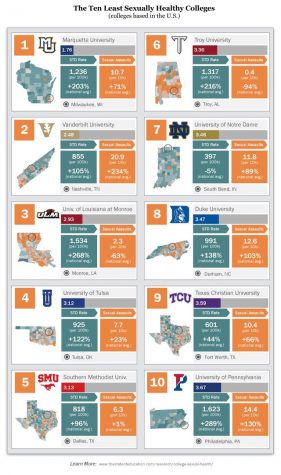You’ve probably heard of several of Vanderbilt’s impressive rankings – second happiest student body, 14th best national university and second best financial aid, to name a few. But unlike these appealing statistics is our apparent ranking as the second least sexually healthy university in the nation. This assertion came from a study (that has since been taken down from the internet) conducted by the data science company called The State of Education. Big name publishers like Vice News and Teen Vogue perpetuated the study’s findings, which were based on controversial sexual assault and STD rate statistics. This is what the State of Education’s findings looked like:

Of the ten universities listed, Vandy is unfortunately a clear leader in sexual assault, and lands at about middle of the pack in STD rate. Vanderbilt seems to be ranked so highly because of our sexual assault numbers. There may be reasons that our rate is so high other than the fact that sexual assault occurs frequently here, however; Vanderbilt students may be more likely to report assault, for example. There is no way to know for sure. Despite the fact that this study deems our sexual assault rate to be the most dangerous of the top ten least sexually healthy universities, Vandy’s rate is notably lower than schools with the highest rates of sexual assault in the country – we don’t even make the top ten. According to the Washington Post, the school with the tenth highest sexual assault rate – Dartmouth – has a rate of 67 cases per 10,000 students, while Vanderbilt has only 20.9, according to The State of Education’s study. Although the sexual assault rate is a pressing issue on campus, by no means are we the second most unsafe in terms of sexual assault. Perhaps STD rates are the culprit of our ranking, then?
Though The State of Education’s study implies that it uses university-specific STD rates in its analysis, the study uses county-specific STD rates instead. In its analysis of Vanderbilt, for example, it sampled STD rates from all over Davidson county rather than from the university’s medical institutions. Davidson county statistics can not be proven to be indicative of the prevalence of STDs within the university’s student body, but they are clearly indicative of the environment in which Vanderbilt is located. With the rise of apps like Tinder and students’ access to nightlife in downtown Nashville, The State of Education’s statistics may have some weight. Notably, according to the Center for Disease Control, “young people aged 15–24 years acquire half of all new STDs,” indicating that these Davidson county statistics used by the State of Education are likely to be made up in large part by Nashville residents who are of college age. However, young people’s contribution to STD rates in each college’s respective county is not unique to our university, and neither is access to dating or hook up apps. Our environment – Davidson county – may be high in STD rates, but it most definitely isn’t the second highest. And that arguably does not prove that Vanderbilt’s student population is as infected as the rest of Davidson county.
As students, we can analyze the accuracy of the study all we want, but it is more likely than not that our STD transmission rate is quite high. Though the study is controversial, analysts do believe that about one in 100 Vandy students have an STD at any one time, and deem our rate to be higher than the norm. According to the Center for Disease Control, one in four college students have or have dealt with an STD at some point during their four years in college. This is the norm, and because we are believed to have a significantly higher STD rate than the norm due to our location in Davidson County, it is likely that more than 25% of Vanderbilt students graduate with more than just a degree. We may not be the second least sexually healthy university, and our rate may not be as high as this study predicts, but as sexually active members of the student body, we must be aware that STDs are likely common on campus.
All in all, there is no certain way of knowing Vanderbilt’s true STD rates for a few reasons. For one, universities’ health centers do not usually release their student body’s STD rates. Secondly, many common STDs – like chlamydia, which Student Health has expressed is the most common STD on campus – can lay dormant in the body for extended periods of time, allowing those infected to potentially pass it to others before experiencing symptoms (STDs can still do physical damage while dormant. See https://www.cdc.gov/std/general/default.htm. for more information).
We’re likely to be sexually unhealthy. So what? There are a few things we should do to perpetuate a healthier sexual environment on campus and to eradicate our (false, in terms of STDs) sexually unhealthy reputation. Firstly, stay calm. Do not let fear impact your sexual choices so long as you are sure to use protection thoroughly (see Sara Saeed’s Hustler article: Negotiation in the Condom Conversation). Secondly, be wary of oral sex, especially when engaging in it without protection. Many STDs can be transmitted orally; either use protection or do not engage in it with untested partners. Remember that it is safer, transmission wise, to engage in protected intercourse than it is to engage in unprotected oral sex. Thirdly, assume that STDs are common, and that they are normal. As indicated before, it is possible that more than one in every one hundred students have an STD at a time here, and that 25% of the student body will have had an STD by graduation day. It’s normal. Part of a sexually healthy environment is the absence of stigma. Be supportive of friends who seek your help and do not be afraid to reach out for help yourself. Odds are you know someone who has or has had an STD here at Vanderbilt. Lastly, understand which types of STDs are prevalent, what the symptoms are, and where to get help. See the Center for Disease Control’s website for more information on STDs: https://www.cdc.gov/std/general/default.htm. Vanderbilt has plenty of resources to help you or a friend if an STD is retracted. Student Health treats STDs with an insurance covered fee, and STD tests are free. The Women’s Center and Project Safe may also be of help.
Vanderbilt is likely to have a high STD rate, but it is unlikely that we are in fact the second least sexually healthy overall. Though this might seem like a relief, it is important that all members of the student body promote a sexually healthy environment – free of stigma, but not free of protection.










